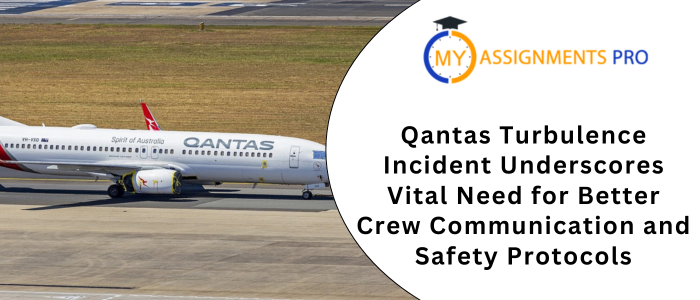
A recent Qantas flight from Sydney to Brisbane has brought renewed focus on the importance of strong communication and coordination between flight and cabin crews. The incident, which saw a cabin crew member suffer a serious injury due to unexpected severe turbulence, serves as a sobering reminder of the risks flight attendants face and the critical role safety procedures play in protecting both passengers and crew.
Severe Turbulence Catches Crew Off Guard
On 4 May 2024, a Qantas Boeing 737 was operating a routine passenger service from Sydney to Brisbane when it encountered a patch of severe turbulence during descent. The aircraft was flying through cloud cover at around 11,400 feet when the event occurred—just one minute after the pilots had switched on the seatbelt signs.
Although the crew expected some light turbulence, the captain did not alert the cabin crew to the potential severity. This lack of communication proved critical. At the time the turbulence hit, cabin crew were up performing standard duties—checking lavatories, securing luggage, and ensuring passengers were seated as per Qantas protocols once the seatbelt sign is illuminated.
According to Dr Stuart Godley, Director of Transport Safety at the Australian Transport Safety Bureau (ATSB), “After the seatbelt signs were illuminated, per operator procedures, the cabin crew were performing various duties… when the severe turbulence was encountered.”
Multiple Crew Injured, One Seriously
The sudden and intense turbulence led to injuries for three of the four cabin crew on duty. Two suffered minor injuries, while a third—positioned in the rear galley—sustained a fractured ankle and was unable to move. This crew member remained on the floor of the galley for the remainder of the flight, unable to relocate to a seat or brace properly for landing.
In a testament to the camaraderie and professionalism of the cabin team and passengers, two crew members (including the Customer Service Manager, or CSM) and two passengers stayed in the galley with the injured crew member. One of the passengers was an off-duty Qantas crew member, while the other was a doctor. All four remained unrestrained during the landing.
Communication Gaps Between Flight and Cabin Crew
This incident revealed a significant gap in communication between the flight crew and the cabin crew. Under Qantas procedures, the Customer Service Manager is responsible for informing the cockpit if the cabin is not secured for landing. The CSM did call the captain and advised them that a crew member had been injured and that some passengers were not yet seated.
However, the captain did not recall being asked for more time to prepare the cabin and, under the impression that preparations were complete, instructed everyone to return to their seats immediately—twice.
“Landing is one of the most critical phases of flight,” said Dr Godley. “Having unrestrained crew and passengers during this phase significantly increases the risk of injury. And if the crew are injured or incapacitated, their ability to respond to an emergency is compromised.”
The Hidden Danger: Crew Are Most at Risk
According to ATSB data, almost 80% of serious turbulence-related injuries in airline operations are suffered by cabin crew. Most of these injuries occur during final cabin preparations for landing—precisely the time when crew are required to be up and moving through the cabin.
This risk is amplified when communication between cockpit and cabin is not crystal clear. “Differing understandings of the state of the cabin increases the risk of delayed responses or misaligned decision-making, which may lead to safety being compromised,” Dr Godley added.
Medical Follow-Up and Post-Incident Procedures Under Scrutiny
What happened after the aircraft landed also raised some red flags. While the cabin crew member with the fractured ankle was seen by paramedics at Brisbane Airport, the other two injured crew members were not assessed immediately. One of them self-identified a facial injury the following day, while the other unknowingly operated multiple flights while experiencing concussion symptoms.
This has raised concerns about how airlines assess and manage crew wellbeing following turbulence or unexpected inflight incidents.
Qantas Responds with Protocol Improvements
In response to the findings of the ATSB report, Qantas has taken steps to improve post-incident care and communication processes. One key change is the requirement for direct contact with the Qantas on-call doctor if there is a significant injury or illness involving cabin crew during a flight.
Additionally, new measures have been introduced to ensure that crew are properly assessed before returning to duty following any turbulence-related event or unexpected aircraft movement.
These changes aim to prevent injured crew from unknowingly working while unfit, and ensure timely medical intervention when needed.
The Bigger Picture: A Safety Culture That Puts People First
While the turbulence event on the Qantas 737 was sudden and severe, experts say it’s not the turbulence itself but the gaps in communication and post-event procedures that are most concerning.
The aviation industry is built on rigorous safety protocols, and this incident illustrates how important it is that those protocols evolve with real-world learnings. As Dr Godley emphasised, better coordination between cockpit and cabin crew is key to maintaining high safety standards and minimising risk during turbulence and other in-flight events.
Lessons for Travellers and Crew Alike
This incident is also a reminder to passengers of the importance of following crew instructions, especially when seatbelt signs are switched on—even if the flight seems smooth. Turbulence can happen without warning, and being buckled in is the simplest way to reduce the risk of injury.
For flight attendants, the event serves as a stark reminder of the occupational hazards they face and the need for open, timely communication with flight crews, particularly during descent and landing.
Final Thoughts
The Qantas turbulence incident is a cautionary tale, but also an opportunity for growth and change. Through its swift response and implementation of new safety protocols, Qantas is reinforcing its commitment to the health and safety of its crew and passengers.
For the Australian flying public, this event highlights the professionalism of flight crews under pressure—and the importance of trust, teamwork, and clear communication at 35,000 feet.
Affordable, Expert Assignment Help for Every Student
Need expert assignment help? My Assignments Pro is here to support students across all academic levels and disciplines. Whether you're studying business, law, nursing, finance, or any other subject, our professional writers deliver well-researched, fully customised, and 100% plagiarism-free assignments tailored to your university’s standards. With quick turnaround times, budget-friendly pricing, and exclusive discounts on bulk orders, we make assignment help accessible and stress-free. Contact us today and take the pressure off your studies.
Source
Mitchell
Mitchell is a seasoned Ph.D. scholar with extensive expertise gained through years of rigorous research, publication, and teaching experience. He brings a wealth of knowledge and analytical skills to tackle complex academic challenges. His work is dedicated to delivering innovative solutions, advancing knowledge, and promoting academic excellence. Proficient in research methodology, data analysis, and scholarly writing, Mitchell has contributed to peer-reviewed journals and mentored students to achieve academic success.


